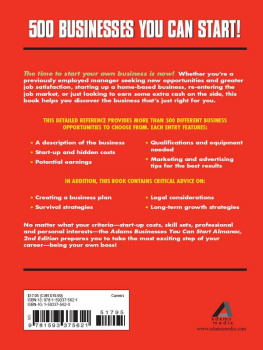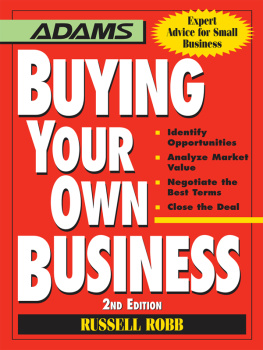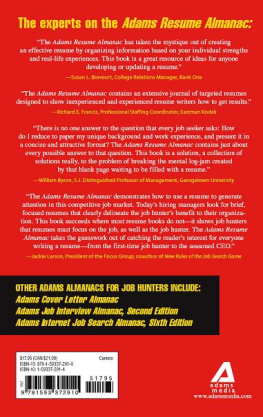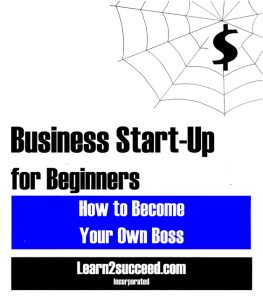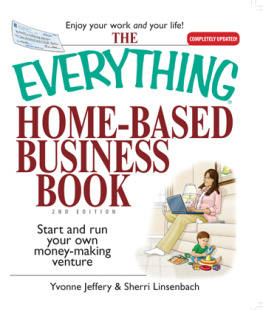ADAMS BUSINESSES YOU CAN START ALMANAC
2nd Edition

Adams Media
Avon, Massachusetts
Copyright 2006, F+W Publications, Inc. All rights reserved.
This book, or parts thereof, may not be reproduced in any form without permission from the publisher; exceptions are made for brief excerpts used in published reviews.
Published by Adams Media, an F+W Publications Company
57 Littlefield Street, Avon, MA 02322. U.S.A.
www.adamsmedia.com
ISBN 10: 1-59337-562-X
ISBN 13: 978-1-59337-562-1
Printed in the United States of America.
J I H G F E D C B A
Library of Congress Cataloging-in-Publication Data
available from the publisher.
This publication is designed to provide accurate and authoritative information with regard to the subject matter covered. It is sold with the understanding that the publisher is not engaged in rendering legal, accounting, or other professional advice. If legal advice or other expert assistance is required, the services of a competent professional person should be sought.
From a Declaration of Principles jointly adopted by a Committee of the American Bar Association and a Committee of Publishers and Associations
Many of the designations used by manufacturers and sellers to distinguish their product are claimed as trademarks. Where those designations appear in this book and Adams Media was aware of a trademark claim, the designations have been printed with initial capital letters.
This book is available at quantity discounts for bulk purchases.
For information, call 1-800-289-0963.
CONTENTS
INTRODUCTION
There has never been a more exciting time to start your own business! New businesses are springing up every day all across the country. Whether these new ventures are inspired by women re-entering the job market, young people starting their careers in home-based businesses, previously employed middle managers seeking new opportunities and greater job satisfaction, or just regular folks looking to earn some extra cash on the side, more and more people are finding themselves caught up in the entrepreneurial spirit.
What has led to this entrepreneurial boom? First, there has been a sharp increase in downsizing at both large and medium-sized businesses. In recent years, many of the larger corporations in the United States, like IBM and General Motors, have been laying off workers in record numbers, and it appears the end is not yet in sight.
As companies are learning to be leaner and meaner, career-minded professionals cannot expect job security the way they could in the past. In today's economy, chances are good that the average individual entering the workforce today will not stay at one company throughout his or her professional career. And a growing number of people feel that the best way to prevent an almost inevitable layoff is to take the skills they have and open up shop for themselves.
Changes in government programs and tax benefits for minority-owned businesses provide still more clues why entrepreneurship is on the rise. Despite affirmative action programs, it is still a statistically proven fact that there is a lack of opportunity for women and minorities within medium- to large-sized companies. Thus, thousands of women and minorities are recognizing that their earning potential is much higher on their own than it would be in the corporate world, and that there is no glass ceiling to block your opportunities when you are your own boss. In addition, it is now easier for minorities and women to get financing to start new ventures, either through local banks or government programs.
The success rate is good for new minority and women-owned startups. According to the U.S. Census Bureau's 2002 Survey of Business Owners, more than one in four owners of U.S. businesses with paid employees are women, and nearly two-thirds of them are at least forty-five years old. And minority-owned businesses are doing particularly well, growing more than four times as fast as U.S. firms overall.
Other population groups are jumping on the entrepreneurial bandwagon as well. Burgeoning technological advances have opened up new opportunities for the physically challenged. In the past, persons with disabilities were limited in their professional choices by their physical handicaps. Affordable computers, the Internet, and greater public acceptance of home offices have opened up a wide range of opportunities for those with physical limitations, and many have launched successful ventures as a result.
The concept of the home office continues to rise in popularity. Many entrepreneurs have even been able to start new ventures while still employed at another firm, thus increasing their capital and minimizing their day-to-day financial risk. With an answering machine, a cell phone, a computer, some letterhead, and business cards, many home-based businesses can literally run themselves while you keep your day job, leaving you to fill orders or talk to clients on your off time. A few years ago, this type of business practice would not have been acceptable. But now, many new businesses are getting off the ground just this way. And if you do choose to quit your day job and work at home full-time, a fax machine and high-speed Internet connection can help you stay in touch with the outside world during business hours, too.
All of these cultural changes working together have created an atmosphere of opportunity in the entrepreneurial environment. The rest is up to you. Making the decision to become an entrepreneur is the hard part. All you have to do now is choose the type of business that best meets your financial, emotional, and intellectual requirements, and get going!
WHY THIS BOOK?
The Adams Businesses You Can Start Almanac is unique among the plethora of business ideas books. The majority of businesses highlighted here are based on the assumption that you already have some area of interest, or skill, that you would like to apply to your own business. Most of the businesses here are considered white collar, but there are also plenty of ideas for the person looking to work with his or her hands. All of the businesses are significant and realistic ventures; the majority of them can be started right in your own home.
This book emphasizes the potential for many businesses to become offshoots of others. Not every business can exist on its own as a full-time enterprise, although many can be used as opportunities for supplemental income. Check the index for companion-type businessestwo part-time opportunities that can be merged into one full-time profitable venture.
Most importantly, this book provides a view from the trenches. In researching this book, we spoke with business owners across the country about how they did it, why they did it, and what they would have done differently. And we were amazed by the frank and honest answers we received. Many business owners were quick to tell us about their mistakes, and even more willing to talk about what they would have done differently if they knew then what they know now. Many of their interviews, and all of their advice, are included in full detail.
Lastly, there's the emphasis on your bottom line. Aside from a brief description of five hundred businesses, there is a thorough analysis of what it will take in terms of money, equipment, and personal qualifications to get each new venture up and running, as well as the kinds of profits you can expect. We've made an attempt to consider the hidden costs for each business, too, so that you can make an educated decision as to which venture is truly the best match for your interest, abilities, and financial resources.
HOW TO USE THIS BOOK
Next page
